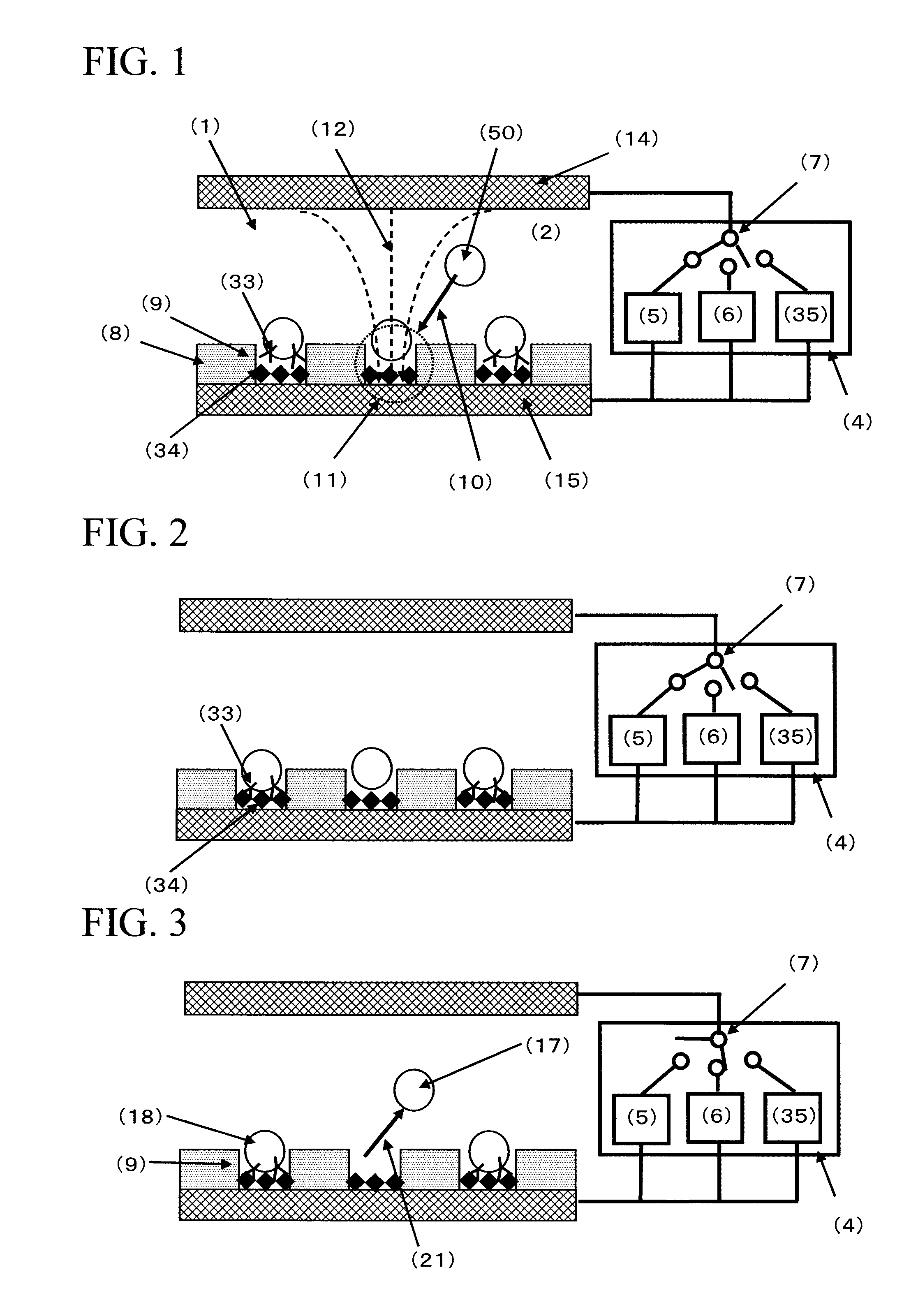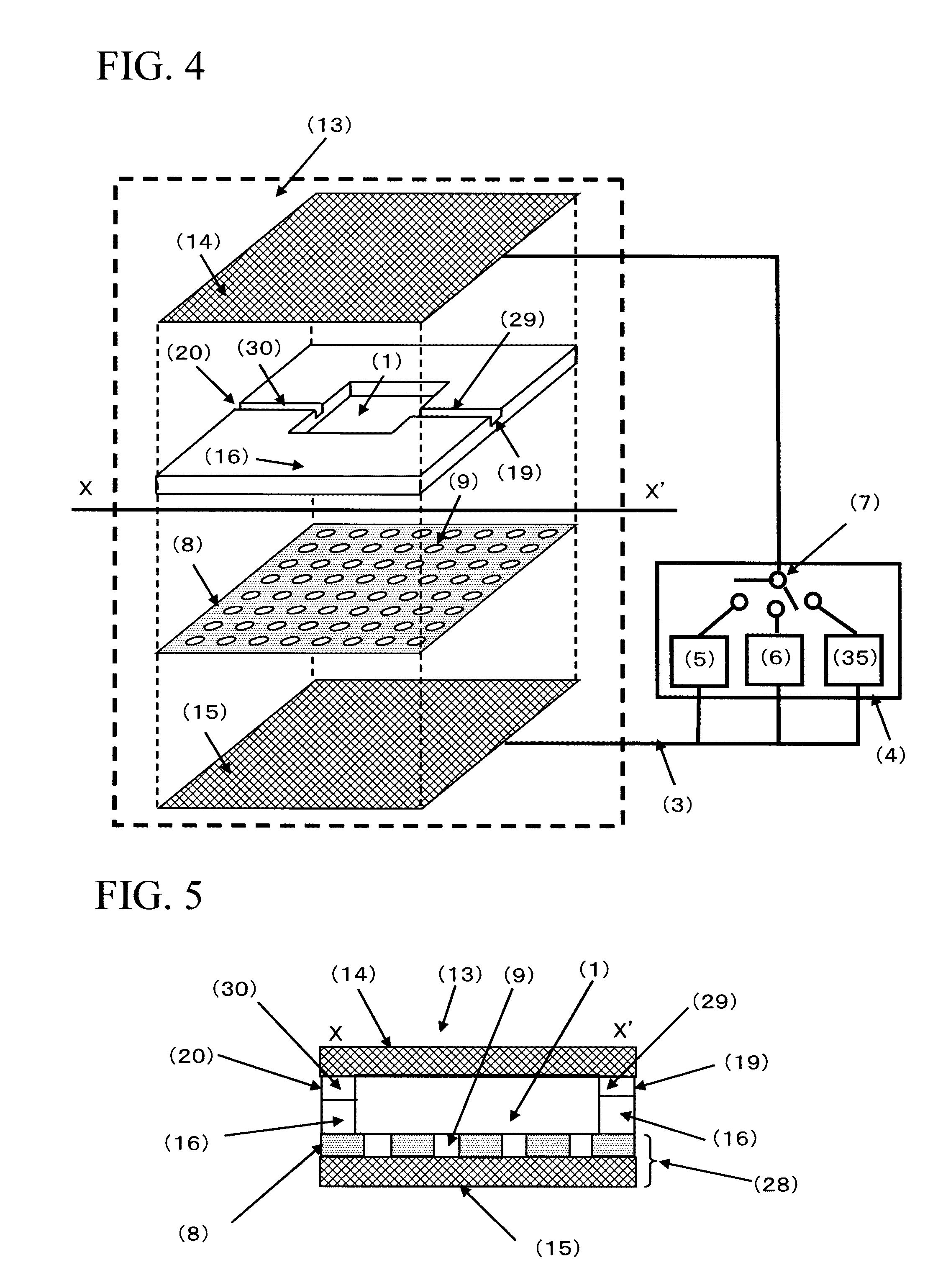Cell selection apparatus, and cell selection method using the same
a cell selection and cell technology, applied in the field of cell selection apparatus, can solve the problems of limited number of samples that can be detected all at once, the inability of the cells per se to produce a mass of antibodies, and the inability to proliferate when taken out from the organism, so as to achieve the effect of further improving the selection efficiency of the fused cell
- Summary
- Abstract
- Description
- Claims
- Application Information
AI Technical Summary
Benefits of technology
Problems solved by technology
Method used
Image
Examples
example 1
[0172]FIG. 4 is a conceptual diagram of the cell selection apparatus used in Example 1. The cell selection apparatus is roughly composed of a cell selection vessel (13) and a power supply (4). As shown in FIG. 4, the cell selection vessel has a structure in which a spacer (16) is disposed between an upper electrode (14) and a lower electrode (15), and an insulating material (8) having a plurality of micropores formed in an array like arrangement is interposed between the spacer and the lower electrode. As will be described later, the micropores have been formed in the insulating material disposed on the lower electrode (15) by usual photolithography and etching.
[0173]For the upper electrode and the lower electrode, a Pyrex (registered trademark) substrate in a length of 70 mm, a width of 40 mm, and a thickness of 1 mm formed with an ITO film (thickness of 150 nm) was used. For the spacer, a silicone sheet in a length of 40 mm, a width of 40 mm, and a thickness of 1.5 mm in the cente...
example 2
[0189]600 μL of the suspension of the antibody-immobilized polystyrene beads whose surfaces were immobilized with anti-E2 antibodies, made by using the mouse anti-E2 antibody solution at respective concentrations of 0, 0.1, 0.5, and 2.0 μg / mL of Example 1 (bead concentration: about 1.65×106 beads / mL), was respectively introduced from the inlet port of the spacer into the cell selection area by using a 1 mL volume dispenser. Then, by leaving it still for about 5 minutes, the antibody-immobilized polystyrene beads were subjected to gravitational sedimentation. Furthermore, by leaving it still at room temperature for about 40 minutes, the antibody-immobilized polystyrene beads inside the micropores were contacted with the bottom faces of the micropores to effect the antigen-antibody reaction between the antibody on the surface of the antibody-immobilized polystyrene bead and the antigen immobilized on the bottom face of the micropore. Subsequently, an AC voltage of 2.5 Vpp having a fre...
example 3
[0194]Using the same cell selection apparatus of Example 1, spleen cells presenting a specific antibody on their surfaces were selected. Regarding the cells, non-immunized mouse spleen A cells and mouse spleen B cells immunized with an E2 antigen were used. In the mouse spleen B cells immunized with an E2 antigen, there exist cells presenting the E2 antibody on their surfaces (hereunder, referred to as antibody-presenting cells). This Example 3 shows an example in which antibody-presenting cells are selected by identifying the binding force of the antigen-antibody reaction between the antibody presented by this antibody-presenting cell and the antigen immobilized on the bottom face of the micropore, based on the magnitude of the AC voltage of the second AC power supply which defines the strength of the negative dielectrophoretic force.
[0195]First, the mouse spleen A cells and the mouse spleen B cells were respectively suspended in a 300 mM mannitol aqueous solution, and each cell su...
PUM
| Property | Measurement | Unit |
|---|---|---|
| AC frequency | aaaaa | aaaaa |
| AC frequency | aaaaa | aaaaa |
| frequency | aaaaa | aaaaa |
Abstract
Description
Claims
Application Information
 Login to View More
Login to View More - R&D
- Intellectual Property
- Life Sciences
- Materials
- Tech Scout
- Unparalleled Data Quality
- Higher Quality Content
- 60% Fewer Hallucinations
Browse by: Latest US Patents, China's latest patents, Technical Efficacy Thesaurus, Application Domain, Technology Topic, Popular Technical Reports.
© 2025 PatSnap. All rights reserved.Legal|Privacy policy|Modern Slavery Act Transparency Statement|Sitemap|About US| Contact US: help@patsnap.com



